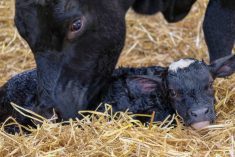On a recent early August morning, I let our dog Luna outside to do her business which amounts to chasing red squirrels and barking to wake up the neighbours. By 10:00 a.m., the temperature was already 30 C in Winnipeg. I noticed that Luna became lethargic, lying on the deck and panting profusely. Within a few minutes, I turned on the garden hose and sprayed her with cold water. The last thing I wanted was a dog with heat stress.
Like Luna, lactating dairy cows can still suffer from heat stress right into September. Therefore, whenever I go into a dairy barn in the fall and see cows lying in their stalls and breathing profusely — more than 80 breaths per minute — I know they still suffer from heat stress. It’s also cows that are excessively salivating while nervously standing around. Other times, it could be a cow near a waterer and staring off into space, not chewing her cud.
Read Also

Harvest wraps up and fall work begins
At the Eppich famly ranch in western Saskatchewan, the fall harvest was successful with few breakdowns, cows and calves have been sorted and a new tractor has arrived
Autumn temperatures will eventually cool off, but there is a long-term side of heat stress that shows itself in the loss of milk production in the bulk tank. For example, heat-stressed early-lactation cows often have a 20 per cent depression in dry matter intake (DMI), which deepens her natural “negative energy balance” because she is not meeting her energy requirements. This problem is only compounded when heat-stressed cows have elevated blood insulin, which suppresses fat mobilization to supply needed energy for peak milk production. As a result, every 0.5 kg loss in DMI during heat stress means 100 kg less milk for the rest of her lactation.
Heat stress prompted action
About 10 years ago, a dairy friend took notice of how heat stress decimated good dry matter intake in his 350 lactating dairy cows. He decided to take corrective action. First, he remodelled his dairy barn to increase general cow comfort. He installed thick foam sheets covered by a durable pasture mat in every stall in his free-stall barn. He then added a sprinkler system along the head gates where the cows come up to eat their lactation diet. Last, he invested in a robot that mixes the bunk feed as it pushes it up to the cows.
Along with these barn changes, my friend also implements the following feed strategies well into the fall to alleviate heat-stress problems:
- Cool drinking water: There are four waterers in his barn to provide enough water to all the lactating cows. They are also within easy reach as soon as the cows exit the milking parlour. It is cool water from a ground-spring source.
- Digestible forages: This sole lactation diet maintains 28 per cent NDF with 75 per cent of this NDF coming from corn silage and alfalfa hay fibre sources. Forages are chopped to provide 15-20 per cent of dietary particles longer than 1.5 inches. No straw or lower-quality hay is added because they elevate the “heat of fermentation” produced in the rumen.
- A well-balanced diet: Forage-to-concentrate ratio is between 40:60 and 60:40 guidelines. A reliable palm fat is fed at 450-500 grams per head, daily. Furthermore, weekly diet samples are tested to maintain the moisture content of the lactating TMR diet between 45-50 per cent.
- Low-moisture molasses blocks: As the photo illustrates, three or four 250-lb. cattle lick tubs are placed in line within the feed bunk. Research shows that by promoting a “licking action” of dairy cows, it will significantly increase the volume of cow saliva and also sodium bicarbonate naturally produced to prevent subclinical acidosis.
- DFM/yeast is fed: A probiotic and yeast are fed to all lactating dairy cows at the rate of 10 g per head, daily. It also contains a B-vitamin complex that mimics a recent Brazilian study (2019) which demonstrated that yeast supplemented with B12 vitamin complex fed to milking dairy cows had increased pasture forage intake and thus milk/milkfat yield during heat stress.
- Reduce mouldy feed: Each batch of fresh feed is made on an 18-hour cycle and put down on a clean feed bunk floor. There is a two- to 2.5 per cent feed refusal that is not fed to faraway dry cows or young stock, but put in a waste pile and effectively disposed.
This is a real “combat heat stress” situation that most dairy producers can still implement during these waning dog days of summer. Sometimes it means turning on the garden hose in the barn to cool off the occasional dairy cow.
















